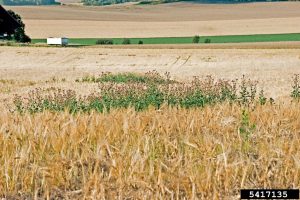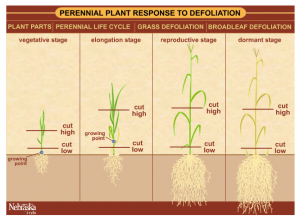Chapter 3: Vegetative Reproduction
3.4 Managing Perennial Weeds

Before leaving the topic of vegetative reproduction in weeds, it is critical to determine how to manage perennial weeds that have this creeping type of nature. What about some sort of defoliation, such as mowing or mechanical tillage? The problem with using this as your only type of control mechanism; is it creates a biochemical reaction in the plant. The plant “knows” when you have mowed off the top of its vegetative structure because it no longer has sucrose (carbohydrates) from photosynthesis coming down into the roots. This is called the “sucrose switch effect” which then elicits survival responses from the plant.
In the following video clip, Dr. Namuth-Covert explains this process, called the “sucrose switch effect”. She talks about how Canada thistle will switch the direction in which sucrose (sugars produced in photosynthesis) move in the plant depending on the time of the year and when the top vegetative tissue is removed.

Work through this animation to identify the effects of defoliation (from tillage, weather damage or chemical means) throughout the growing season on plants.
http://passel.unl.edu/pages/animation.php?a=perennialdefoliation.swf
Ecological Plant Succession
Although it is difficult to remember in our modern farming practices that our fields are a part of a larger ecosystem and those dynamics, understanding this can be helpful in developing long term weed management strategies. One of these dynamics is known as “ecological plant succession”. In the next video clip, Dr. Namuth-Covert briefly describes this phenomenon. You can then apply this to our modern farming practices in the scenario which follows.
Practice Activity
For each of the following cropping practices, what types of weeds (annuals, biennials, perennials, woody types) do you think you would most likely tend to have more challenges with?